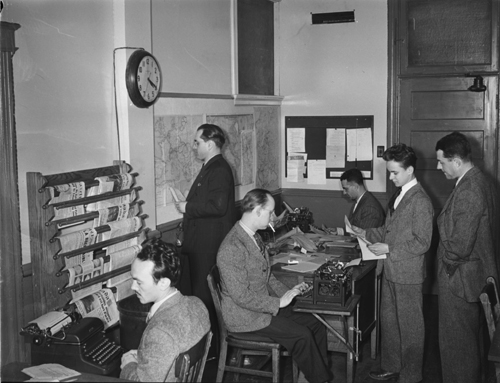
Image Credit:
Photo by Corand Poirier via Bibliothèque et Archives nationales du Québec (reference #P48,S1,P23104)
It’s been a few months since we had Criterion co-founder and innovator extraordinaire, Bob Stein, on campus, and since his visit I’ve been thinking quite a bit about the things he had the say. For those of you who missed it, Stein was showcasing a few new projects related to the future of the book, centered on the idea of social reading (you can hear Zeugma’s great interview with him here. Essentially, he argued that our understanding of reading is stuck in the 19-century and that technology has opened up new avenues for all kinds of new reading practices that could transform education. He wasn’t just talking about distribution modes like ebooks either. Instead, he was suggesting ways in which the book could be read and discussed community: discussions would flow beyond the classroom and a student would never have to face a difficult text alone. While, the technology that enables this kind of seamless discussion isn’t quite ready yet, I’ve been thinking about the concepts behind Stein’s idea. How did it apply to my teaching practice? Were there ways in which I could test some of these notions out in a first-year rhetoric and writing course (RHE 306)?
My first thought was writing itself. In 306 I spend a lot of time talking to students about their experience typing. It never takes long for the horror stories to come out: the all-nighters, the embarrassing typos, the misunderstood prompts, and, perhaps above all, the terrible blank page, ticking clock, and languishing page requirement. Of course, all of these problems are “student problems” and, though the isolation of writing is critical to its mastery, there are also ways in which the structure of 306 feeds into its less-than-welcoming appearance. In most courses a student’s work is a private affair, graded under cover of night (well, for most of us) and then discussed with hushed voices in tiny cubicles. But maybe it doesn’t have to be this way. This spring I began instituting formal writing groups in my 306. I borrowed this from my experience in Journalism School. Instead of one-on-ones, I decided to block longer meetings with small groups of between four and five students. Every student would have to read all of the other papers in their group and be prepared to share a comment on their writing. Praise doesn’t count. This sounds a little mean, but it’s not hard to keep it in the spirit of good fun. There’s a bad writer in all of us and the best way to root him out is to acknowledge his existence. I usually started meetings by finding terrible sentences that I had written in my own undergraduate papers. We would laugh together and then diligently pick apart the writing. Then, one student at a time, we would look at awkwardly phrased sentences, silly typos, and all kinds of convoluted language with that same care. At first this can be a little off-putting, but the slight embarrassment and knowledge that other people, your peers, will be reading your work, can be a very helpful motivator, and its not hard to keep things light-hearted when you have that much material. These meetings have proven so useful that I began to work them into the in-class peer-review workshops and my grading methods. On a recent paper I decided that instead of providing any marginal comments I would write each student a letter about their work, offering general instructions for improvement but without any specific prescription. Then, in the peer workshop I sat my students in a large circle and instructed them to take out an extra copy of their paper. Some students had expressed anxieties about their own proofreading, so I decided to help them defamiliarize their own writing. We began a “rapid line edit.” I had each student pass their paper to the person on their left then check for one thing about the paper. On the first pass they circled every main verb (and emphasized weak verbs with sad faces or extra circles). On the second pass they found the longest sentence and the shortest sentence in the paper. On the next pass they looked for thesis statements, then topic sentences, then transitions, et cetera. In each case classroom discussion flowed naturally from the exercise and, perhaps because of the open environment that we had built in our small meetings, students seemed comfortable asking questions like “What exactly is a main verb?” or “What is the difference between a Topic Sentence and a Thesis?”. And, as I clarified my terms and taught short lessons on grammar students cheerfully volunteered broken and beautiful passages alike. At the end of class I handed back my letters to each student with their grade and they went home with my comments, and a copy of their paper filled with all kinds of zany marginalia that could guide their revisions.

